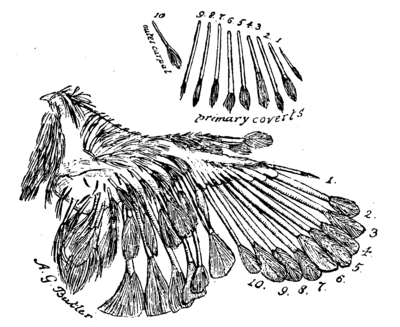loped wings of some species, in order to make quite certain of our fact before recording it.
From several nests of Passer domesticus, all of which unfortunately contained eggs only, one egg (incubated about nine days) contained a young bird from which a wing could be obtained. When placed under the microscope nine primaries were already commencing to appear from their follicles, but the first primary, the follicular depression of which was well defined, had not yet appeared.
A few days later, several young Canaries, which died seven and nine days after leaving the egg, were found to have all ten primaries, with their coverts, perfectly clearly developed; we were thus compelled to come to the conclusion that the accepted definition of these three families, Fringillidæ, Motacillidæ, and Hirundinidæ should be modified, and that, instead of the statement that the first primary is absent, the following should be substituted:—"The first primary is concealed within its coverts." It seems to us that the only explanation of the supposition that no first primary existed, is that the student has in every instance removed the concealed primary when taking off the under wingcoverts to trace the origin of the quills.
r 2

